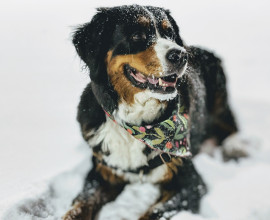 Shorter days and colder temperatures are here to stay, as we stare down the barrel of winter’s arrival. As we transition into a new season, there are inevitably changes to our day-to-day lives. Some subtle, others, not so much.
Shorter days and colder temperatures are here to stay, as we stare down the barrel of winter’s arrival. As we transition into a new season, there are inevitably changes to our day-to-day lives. Some subtle, others, not so much.
Winter presents unique challenges for dog owners, as frigid temperatures force us to stay indoors more. Dogs, just like us, are typically less active during the colder months, so it’s no coincidence that winter is when most dogs gain weight. After months of warm weather and lots of exercise, an active dog can easily burn off extra calories. It’s not so easy during winter.
Changes in Diet
As a dog’s activity level changes, so does their caloric requirement. The more active the dog, the more fuel needed for optimal health. As winter generally brings a decrease in activity for dogs, their food portions oftentimes stay the same. Less exercise without fewer calories is a recipe for an overweight pooch.
Food is also an easy go-to for pet owners hoping to keep their dogs occupied. Food is a wonderful tool to utilize for a variety of engaging activities, however just be sensible about portions otherwise things can get out of control quickly. Consider substituting calorie-rich treats with lean alternatives, like carrots, for example. You’d be surprised how many dogs actually like veggies!
Weight gain and stool inconsistencies are tell-tale signs your dog may be consuming more than he needs. Remember, most dogs want more food, however few dogs actually need more food. The line between want and need can get blurry; dogs are master manipulators.
Simply put, think about your dog’s changes in activity during winter, and adjust his food portions accordingly.
Outdoor Activity
Nobody wants to feel cold. But your dog still needs exercise, right? So how do you ensure your dog gets enough activity to burn off his pent up energy without turning your fingers turning into popsicles?
The solution is simple. Get creative with your time, and encourage exercises that burn lots of energy in short periods of time. Consider visiting an off-leash dog park. A dog can easily burn more calories in a half an hour of play time at the park versus hours of walking. Off-leash trails, like the ones at Memorial Park, are great settings for off-leash play that will satiate even the most high-energy breeds.
Alternatively, consider visiting any open area, like a park or field, and tether your dog to a 50-foot long line. Long lines provide dogs with plenty of space and freedom to run and play, while the owner is still fully in control. It’s off-leash-esque, if you will.
Indoor Stimulation
Since many dogs experience a decrease in outdoor time during the winter months, it is easy for them to get bored. This often results in chewing, barking, and other unwanted behaviours in the home.
Providing your dog with activities in the home can give him the stimulation needed to stay calm and balanced. For food motivated dogs, use that appetite to your advantage. Treat balls are popular; they require your dog to think about moving the ball around to get the treats out. Activities like these can last hours. Just be sure to monitor your dog’s portions, as you don’t want those extra pounds to pack on. During the winter, many pet owners will feed their dog’s meals via a treat ball. It’s fun, it’s healthy, and it’s engaging.
Other activites you can do around the home include:
-
Hide toys and treats around the house for a doggy scavenger hunt
-
Play hide-and-seek
-
Learn new tricks
-
Work on obedience techniques
-
Use stuffable toys and treats
-
Play the ‘guess the hand’ game with treats
-
Massage, reiki and other therapeutic treatments
Cleanup
Winter is a sloppy season. Mud, slush, salt, snow, sand, you name it, if it gets on our boots, rest assured it’s getting on your dog’s paws, too.
Consider protecting your dog’s precious paws from the elements with boots. Contact with ice, snow, and salt can damage sensitive foot pads, and may shorten outdoor time considerably.
Always keep a towel handy to wipe your dog down when it’s time to come inside. Pay particular attention to the feet, legs, and stomach areas.
To keep your vehicle free from dog messes, consider a vehicle hammock or seat covers. They are easily washable, and will protect your vehicle’s interior from fur, dirt, and more.
There you have it, your essential winter hacks for dog owners. Even though the frigid climate presents certain challenges for the dog-loving populace, by making a few smart choices, you can easily have a consistently well-balanced pooch.
Brandon Forder – also known as The Pet Expert – is vice-president of Canadian Pet Connection, a family-owned and -operated business located in Meaford. He has over twenty-five years experience specializing in pet nutrition, behaviour, and healthy pet lifestyles. Canadian Pet Connection is an industry leader committed to providing their clients with the highest levels of personal, attentive service. Learn more at www.CanadianPetConnection.ca.











